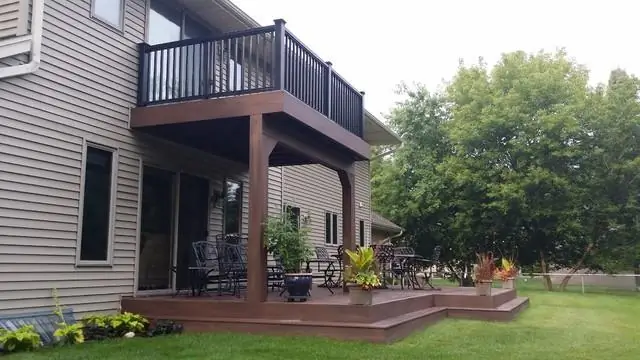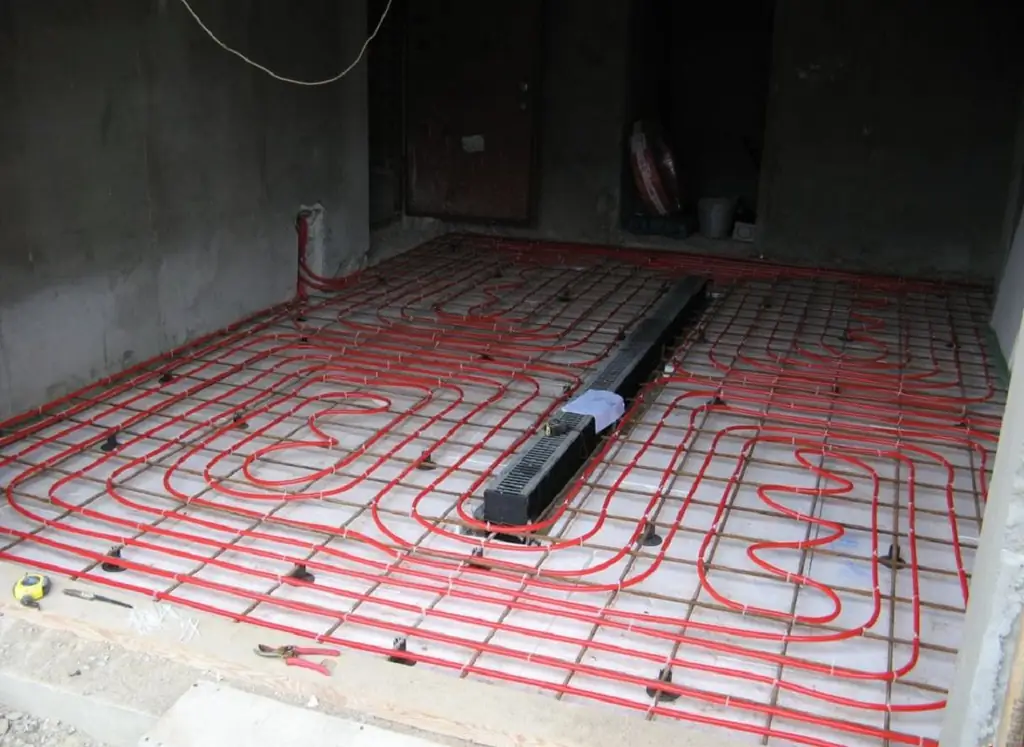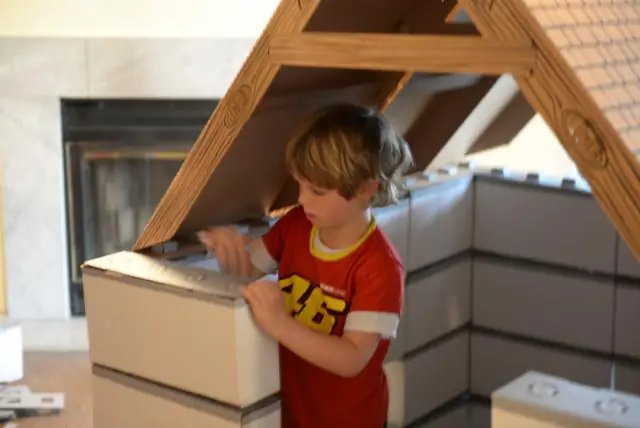
Table of contents:
- Author Bailey Albertson [email protected].
- Public 2024-01-17 22:26.
- Last modified 2025-06-01 07:32.
How to make a cheap built-in wardrobe made of wood and other materials on a balcony or loggia with your own hands

Residents of small apartments, due to the tightness, often face the problem of storing things. At the same time, the balcony is usually empty or turned into a place where unnecessary belongings are simply dumped. How to avoid clutter? The best way to do this is to build a closet with your own hands using affordable lumber. This is not easy enough, but everyone can do it. We present ideas, drawings, diagrams, sketches and manufacturing technology for balcony cabinets.
Content
-
1 What can be cabinets for balconies and loggias
- 1.1 Door options - photo gallery
- 1.2 The most suitable and cheapest materials for building and arranging cabinets
- 1.3 How and from which lumber to build a frame for a cabinet
- 1.4 Original, beautiful and easy-to-manufacture built-in furniture on the balcony - photo gallery
-
2 Ideas, diagrams, drawings and step-by-step instructions for assembling balcony cabinets
- 2.1 List of tools required for carpentry work on the arrangement of wooden cabinets.
- 2.2 Stages of self-assembly and arrangement of the cabinet
- 2.3 Selection of materials for cladding and doors
- 2.4 Installing doors on a built cabinet
- 2.5 Using drywall
- 2.6 Do-it-yourself wardrobe on the balcony - video
- 2.7 How to equip a corner cabinet from lining
- 2.8 The use of plastic panels in the manufacture of balcony furniture
- 2.9 How to make a wardrobe and a curbstone for a window for a balcony or loggia - video tutorial
What can be cabinets for balconies and loggias
Cabinets can be of two types:
- A cabinet cabinet, which is an independent structure and is not attached to the balcony walls in any way. Such a cabinet takes up a lot of space, but at any time it can be moved or removed.
- Built-in wardrobe, which, as a rule, is created according to an individual project, therefore fits perfectly into all the "inconvenient" places of the loggia or balcony. But in such a cabinet, the walls of the house are used as load-bearing structural elements, to which the side racks and shelves are attached, so it is impossible to move or remove it without completely dismantling it.
Doors of the following types are used in cabinets:
- compartment doors;
- accordion door;
- roller shutters;
- swing doors
The final choice of the appropriate option depends on the specific conditions. For example, a built-in wardrobe can be installed in the loggia. In this case, the walls will simultaneously serve as his back wall. But on an open balcony it is better to put a regular cabinet cabinet.

A correctly placed cabinet will streamline the space on the balcony or loggia
Particular attention should be paid to the choice of doors. If there is not enough space on the balcony, it is more practical to install roller shutters, compartment doors or an accordion. Hinged doors will be more convenient in a large loggia, where you do not need to save space and you can simultaneously access all the shelves by opening the cabinet. The doors can be installed in the entire height of the cabinet, but sometimes it is more convenient to divide the structure into 2-3 functional zones, each of which will have its own doors.
Swing doors are the simplest and cheapest. To assemble them, you only need door panels and hinges, and self-installation in the opening will not be difficult. Sliding systems are more expensive and time consuming to install. In addition to door leaves, they will require guides and rollers. But when opening, such doors do not go beyond the dimensions of the cabinet, which can be attributed to the advantages of such a system.
The most expensive door option is roller shutters. They are custom-made and assembled by the manufacturer.
Door options - photo gallery
-

Wardrobe with hinged doors - Swing doors are the easiest and relatively cheapest option, but they are not always convenient
-

Built-in wardrobe on the balcony - Convenient and economical option - compartment doors
-

Wardrobe with an accordion door - Folding accordion door when open does not take up much space
-

Roller shutters on the cabinet -
Roller shutters as doors to a balcony cabinet - a convenient but expensive option
The most suitable and cheapest materials for building and arranging cabinets
Before starting the manufacture of the cabinet, it is necessary to decide on the material from which it will be made. The most popular and accessible materials are:
- plastic;
- Chipboard - chipboard;
- wood;
- drywall.
When choosing a material, they usually take into account the general design concept of the balcony, as well as their own financial capabilities. Plastic is very convenient here - it is practical, goes well with the interior of the balcony and is easy to use.
In the general case, the cabinet design is a frame, doors and so-called filling - shelves, drawers, hangers. If there is a side post, then sheathing is also needed for it. Often, all of these components are made from different materials.
How and from what lumber to build a frame for a cabinet
Most often, the rack frame for the cabinet is assembled from a wooden bar with a section of 40x40 or 50x50 mm. It should be borne in mind that the tree changes size under the influence of moisture - the timber swells, deforms, the joints shift, therefore, for unheated balconies, such a cabinet will not be the best option.
Here, a frame made of galvanized profiles, which is not subject to deformation at high humidity, can help out. Plywood, drywall, chipboard and other materials are easily attached to it.
Original, beautiful and easy-to-manufacture built-in furniture on the balcony - photo gallery
-

Wardrobe along the balcony window - A long wardrobe placed under the window along the balcony will accommodate even more things
-

High built-in wardrobe - High two-level wardrobe with hinged doors and side unit
-

Wardrobe under the window with sliding doors - Small cabinet under the window, lined with plastic
-

Curbstone on the loggia - A low cabinet under the window, or a cabinet for the balcony, will serve as a table at the same time
-

Wardrobe and shelves on the loggia - Comprehensive solution: high cabinet with doors and open shelves along the loggia
-

Corner cupboard - Built-in corner wardrobe
Ideas, diagrams, drawings and step-by-step instructions for assembling balcony cabinets
After you have decided which type of cabinet will be most convenient for you, you need to start creating the most accurate drawing. Below are several designs for your attention, designed just for installation on a loggia or balcony:
-
The simplest version of a rack, consisting only of shelves. This model does not imply the installation of doors, but you yourself can calculate their dimensions and mount them, fixing them to the front frame.

Built-in shelving Simple built-in shelving scheme
-
The second option is designed for installation in a wide loggia. In such a cabinet you can store clothes on hangers. True, it is desirable to place it on a warmed, or better - a heated balcony.

Built-in wardrobe with storage compartment Drawing of a wardrobe for a large loggia
-
The third option will fit perfectly into a narrow balcony, and will also be an excellent addition to a table or cabinet. You can, if you wish, install additional removable shelves on the corners yourself.

Wardrobe rack with hinged doors Wardrobe rack with hinged doors for a narrow balcony
After reviewing the presented drawings, you can easily draw up your project by changing or adding some parameters in accordance with the dimensions of your balcony.
List of tools required for carpentry work on the arrangement of wooden cabinets
- self-tapping screws, dowels, nails;
- a hammer;
- chisel;
- jigsaw or hand saw;
- electric drill with attachments for woodworking;
- screwdriver (set of screwdrivers);
- ruler, pencil, tape measure, plumb line, square and building level.

You will need a drill, screwdriver, screwdrivers, hammer, chisel and other tools
Here are some more simple tips before building a cabinet on the balcony:
- On a pre-glazed balcony, the wood finish will not suffer from dampness, it will retain its attractiveness and good quality longer.
- It is advisable to pre-repair the floor on the balcony, or at least that part of it on which the cabinet will be installed.
- It is advisable to eliminate all cracks and crevices, insulate the walls and floor of the balcony, which will provide protection against temperature changes and drafts and significantly extend the life of the cabinet. For insulation, you can use foam, PVC, or mineral wool.
After the measurements are made, the type of cabinet is selected, the drawing is drawn up, you can start directly to work.
Stages of self-assembly and arrangement of the cabinet
Even a beginner can easily cope with this cabinet. To make it you will need the following materials:
- pine timber 40 X 40 mm for the frame;
- metal corners for connecting elements;
-
boards or sheets of chipboard for shelves.

Pine bar Pine timber is the best option for making a cabinet frame
The amount of pine timber must be calculated taking into account the selected dimensions of the future cabinet. For simplicity, we will take the standard dimensions that are most suitable for the balcony space: height - 1.8 m, width - 1.5 m, depth - 0.5 m. Accordingly, a beam will be required:
- for the lower frame 2x0.5 + 2x1.5 = 4 m;
- for the upper frame 2x0.5 + 2X1.5 = 4 m;
- for vertical racks 4x1.8 = 7.2 m.
As the back wall of the cabinet, you can use a sheet of laminated fiberboard. This dense and water-resistant material will additionally protect the structure from dampness, it is attached to the rear frame using a construction stapler or self-tapping screws.
-
First, assemble the back and front cabinet frames. To do this, fasten the vertical and horizontal beams together using metal corners.

Fastening panels with metal corners An example of fastening elements to metal corners
-
Instead of corners, the beams can simply be connected with self-tapping screws on wood 60-75 cm long, as you can see in the photo below.

Cabinet frame Frame beams can be connected with nails or self-tapping screws
-
Then attach the rear wall of the cabinet with self-tapping screws or staples of a construction stapler to the rear frame of the frame. After that, fix the resulting structure in the opening of the loggia using anchors. At this stage, you can lay a sheet of thick plywood or chipboard on the floor under the future cabinet, which will serve as the bottom.

Built-in wardrobe frame Fix the chipboard sheet as the back wall of the future cabinet
- When the frame is in place, attach the crossbars to it and secure them with anchors.
- Attach the front frame to the ends of the beams. Then fix it with anchors in the walls, floor and ceiling - this will stiffen the structure.
-
It remains to fasten the guides with self-tapping screws, which will become holders for the shelves. The length of the horizontal part of the rail must be equal to the depth of the cabinet. Place the cut-to-size shelves on the rails, securing them with self-tapping screws if necessary.

Wardrobe with shelves Shelves inside the cabinet are fixed with rails
Basically, a simple wardrobe is ready. In it you can conveniently place almost everything that is usually stored on the balcony: cans, boxes of clothes and small things, tools. It can also be used as a bookstore or for storing old magazines. But if there is a need to completely hide the contents of the cabinet, this structure can be equipped with doors and sheathed with clapboard or drywall.
Selection of materials for cladding and doors
The next thing to consider is the quality of the material. The cost of the lining also depends on its grade: A, B or C. Grade A material is smooth, uniform in color, it is ideal for both cladding and furniture. Grade B has blotches of a different color, slight roughness and unevenness, but good in terms of price-quality ratio. But grade C lining is not suitable for cladding: an uneven surface, cracks, chips and rough colors will not add aesthetics to the finished product.

Division of lining by grades
Installing doors on a built cabinet
- Fit a frame for doors made of thin beams or boards according to the dimensions of the cabinet frame. Fasten the elements with nails or self-tapping screws (or you can use metal corners). To ensure the rigidity of the structure, install a lintel across or diagonally inside the frame.
-
Place the frame on the floor. Lay the cut-to-size lining on the frame so that the boards lie tightly to each other. After fixing the lining to the frame, install the handles, locks, trims (optional) and internal hinges.

Lining Lay the lining boards for sheathing as tightly as possible
- Fasten the door hinges to the cabinet frame and hang the doors on them.

Doors can be decorated with platbands
Using drywall
Instead of lining, you can use an even simpler and cheaper option - drywall. It looks great on a finished structure and is easy to mount onto a ready-made frame.
-
First, line the frame with sheets of drywall cut to fit the cabinet. Drywall is attached to the frame with self-tapping screws.

Fastening drywall to wooden slats Cut to size sheets of drywall are attached to the frame with self-tapping screws
-
After the frame sheathing is completed, you can start finishing. Glue the drywall joints with reinforcing tape, putty and sand. Prime the surface and, after drying, coat with water-based paint. Alternatively, it is also possible to paste drywall wallpaper to match the interior of the balcony.

Sealing drywall joints The joints between drywall sheets are pasted over with reinforcing tape and putty
-
Now it remains to assemble the doors. In this version of the cabinet, it is preferable to install sliding doors. Due to the abundance of spare parts, it seems difficult, but the diagram will easily help you understand the task.

Sliding door scheme Design of roller sliding doors for wardrobes
Do-it-yourself sliding wardrobe on the balcony - video
How to equip a corner wardrobe from lining
The advantages of lining as a finishing material have long been appreciated by home craftsmen. In particular, loggias are often sheathed with it. We suggest you do not limit yourself to this, but construct a convenient and beautiful corner cabinet from the same lining. Such a design will be both roomy and compact, moreover, it will not block the windows.

Sketch of a corner cabinet for installation in a loggia or on a balcony
The assembly method for the corner cabinet is similar to those already discussed above, but has some features:
- There is no need to attach the stands. It is enough to nail the bars on the ceiling and floor, and fix the walls on them.
- Do not make them too wide, 3 boards for each are enough.
- Nail the planks to the lining on the walls, lay the shelves from the same lining, cut to the shape of the cabinet, on them.

Fix the walls of the future cabinet on the bars, install the shelves
Now you need to hang the door. We recommend making it swing:
- From the bottom and top of the opening, stuff 1 plank across.
- Measure the remaining distance, subtract 1.5 cm for the inaccuracy.
- Measure the lining to the stated length.
- Adjust the number of planks according to the width of the doorway. In our case, 6 of them were required.
- Knock them down into one canvas using 4 cross bars and hang them on simple door hinges.

Door hinge on corner cabinet
The use of plastic panels in the manufacture of balcony furniture
It often happens that the installation of a drywall cabinet, lining and chipboard is impossible. These materials are sensitive to moisture, and it is sometimes difficult to make a full waterproofing on a balcony or loggia. In this case, plastic panels will come to the rescue. They have many advantages over other materials:
- excellent moisture resistance;
- ease of maintenance - the product is easy to clean, does not suffer from exposure to chemicals;
- wide selection and affordable price;
- the material is not afraid of exposure to high and low temperatures, sunlight;
-
plastic shelves withstand a load of about 40 kg.

Wardrobe made of plastic panels on the balcony Plastic panels for the manufacture of balcony cabinets have advantages over other materials
The principle of installing a cabinet made of plastic panels is identical to those described above, but there is one nice feature. Plastic is a fairly flexible material, and you can make the back and side walls from one wide sheet by folding it in the desired areas. A thick two-layer sheet before folding it is enough to cut one layer at a time. In addition, the sheet can be cut into panels of the desired width and fastened together with special fasteners.
Plastic panel doors are very lightweight and easy to install. If the issue of saving money is not urgent for you, you can order ready-made doors of the required size from the company.
How to make a wardrobe and a curbstone under a window for a balcony or loggia - video tutorial
Cabinets, shelves, and cabinets are a great way to organize your space, especially if you don't have much. This means that they are necessary for the balcony and loggia. We hope that our tips will help you equip your balcony, make it functional, cozy and beautiful. Tell us in the comments about your experience in arranging small isolated spaces such as loggias and balconies, or ask any questions that arise on this topic. Easy work for you!
Recommended:
How To Make A Veranda With Your Own Hands To The House - Instructions, Projects, Drawings, Photos And Videos

The article describes how to build a veranda close to the house with your own hands
How To Make Heating For A Garage With Your Own Hands - Instructions With Photos And Videos

Various methods of heating the garage, their efficiency and cost, as well as detailed instructions that will allow you to do all the work yourself
How To Make A Shed With Your Own Hands From Foam Blocks - Instructions With Photos And Videos

Every owner knows about the need for a barn on the territory of home ownership. Everyone can build this necessary outbuilding without the involvement of specialists
How To Make A Slime At Home With Your Own Hands - Without Sodium Tetraborate And Glue, From Hand Cream, Shaving Foam And Other Ingredients, Recipes With Photos And Videos

Is it possible to make a slime at home. Types of slimes and recipes for their manufacture, depending on the desired properties. Toy care features
How To Make A Kuznetsov Oven With Your Own Hands: Diagram, Ordering With Photos And Videos, Etc

Step-by-step instructions for installing a heating furnace-blacksmithing. Selection of materials and necessary tools. Rules for effective operation of the unit
